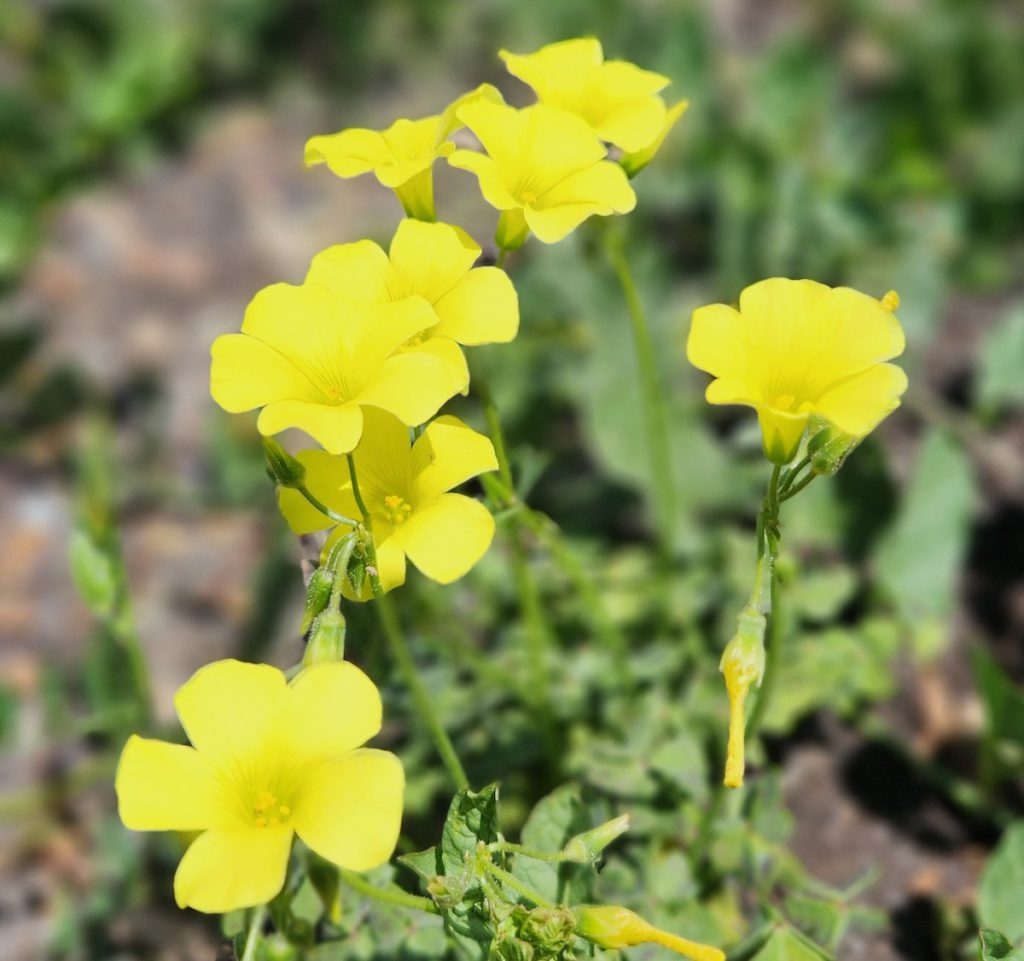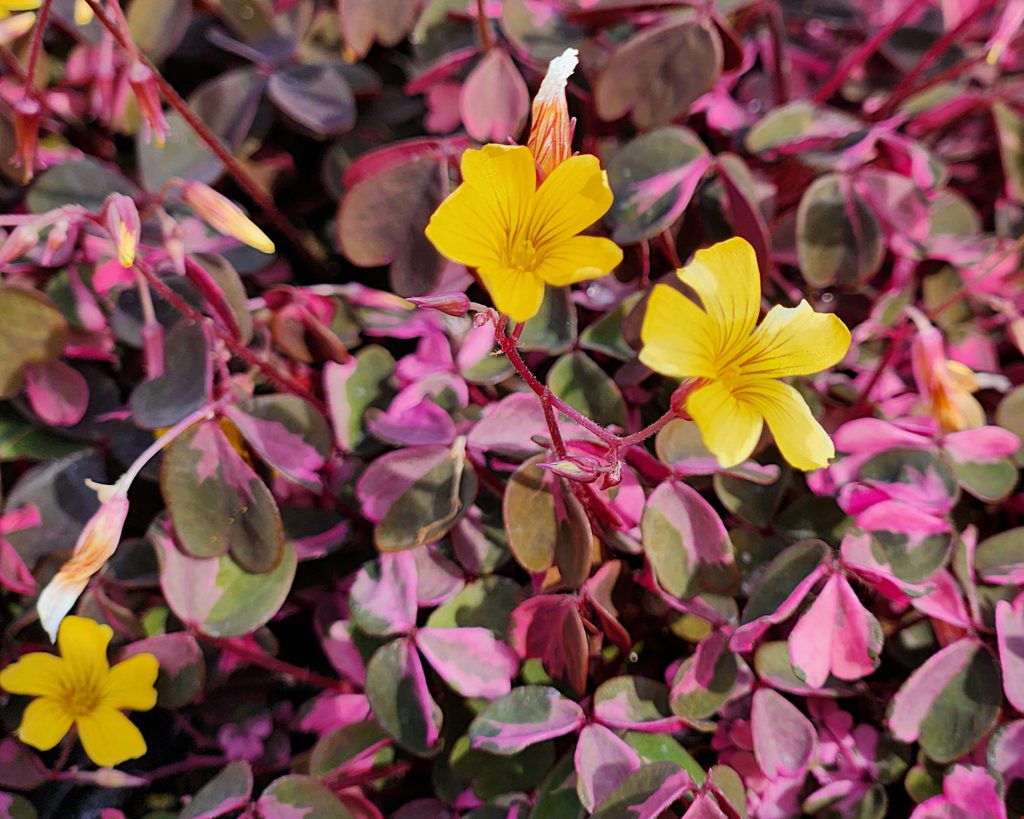“One man’s treasure is another man’s trash” is an old idiom that continues to be relevant today. Examples include used cars, salvaged building materials and preowned clothing. Oxalis, the plant with the bright yellow flowers and clover-shaped leaves that pops up in the garden every spring is a good example of “One gardener’s treasure is another gardener’s trash.”
Oxalis pes-caprae, also called buttercup oxalis, Bermuda buttercup or sour grass, is a plant from South Africa that was introduced to California as an ornamental around the early 1900s. It can be seen in the spring and early summer growing in many natural and urban areas here. It has a yellow daisy-shaped flower that sits on a six-to-12-inch stalk rising from a cluster of chartreuse clover-shaped leaves.
Many people find Oxalis attractive when it grows en masse along freeways and in open spaces. Only some find it attractive when it is growing in their garden.
Many people find Oxalis attractive when it grows en masse along freeways and in open spaces. Only some find it attractive when it is growing in their garden. Many others detest it.
Growing buttercup oxalis in the garden is easy for anyone who treasures it. It is not spread by seeds but rather small bulbs that sprout in spring. Simply leave any existing oxalis in the yard or introduce some of the bulbs into the garden, and year after year they will multiply. They need no supplemental water or fertilizing.
This species of oxalis is invasive and it will spring up throughout the garden since bulbs are persistent and multiply quickly. However, the plant completely dies back with the summer heat and does not resprout until spring temperatures are consistently above 50°F.
The main reason most people dislike buttercup oxalis is because it is invasive. Gardeners who think that it’s “trash” can eradicate it, but it does take more work than other weeds. Oxalis pes-caprae bulbs multiply rapidly and stay dormant for several years. Herbicides will kill the above-ground foliage but not the underground bulbs.

It can take multiple applications over a couple of years to finally rid a yard of oxalis. Cutting or using a weed eater is a safer way to weaken and eventually kill the bulbs, but this method can take several years. Sheet mulching can provide immediate results, but as the cardboard breaks down, dormant bulbs will sprout again. The most effective way to eradicate buttercup oxalis is to dig it up and remove the bulbs.
The story of oxalis in California does not end here, however. There are many other species, including some native to California that are attractive to grow in the garden or as house plants.
Oxalis californica
This perennial native plant, commonly known as California wood sorrel, can be found growing throughout southern California in open spaces from sea level to 6,000 feet. It is low-growing with dark green clover-shaped leaves and has pale yellow flowers with a brush of red in the center.
Oxalis oregana
This plant’s native habitat ranges from British Columbia to Northern California. It can be found carpeting the ground in many redwood forests, which is why it’s commonly referred to as redwood sorrel. It grows well in partial to deep shade. It has clover-shaped green leaves with flowers that range from white to pink.
Oxalis spiralis aurea
This showy plant will brighten up any indoor or outdoor partially shady location with its bright green, pink, orange, copper and yellow foliage and red stems. It also has bright yellow flowers that bloom on and off throughout the year.
Oxalis ‘Plum Crazy’:
This non-invasive ornamental plant has small clover-shaped leaves which have patches of pink, fuchsia, purple and green and are most vibrant when growing in full sun. However, it grows well in the shade and can bloom all year long in moderate temperatures with bright yellow flowers.

Oxalis spiralis vulcanicola
This elegant plant, also known as volcanic sorrel, has leaves that range from dark green to red, maroon, purple and an almost black burgundy. It is a perennial plant in the milder Bay Area climates and indoors. It can also bloom all year long with bright yellow flowers that sit atop dark red stems.
Oxalis versicolor
Many oxalis species have flowers that close in cloudy weather and at night. However, only one, also known as Candy Cane sorrel, is purchased primarily for when flowers are closed. When open, the flowers are dark red with a single white stripe on each petal. When closed, the flowers curl into cylinder shapes with red and white stipes that resemble candy canes.
Most gardeners who hate buttercup oxalis do so because it is invasive, while ignoring its other positive characteristics. There are other types of oxalises that are non-invasive, have colorful foliage and vibrant flowers, are drought tolerant, and take little work to maintain.
Growing and enjoying these other species may help people treasure the invasive Oxalis pes-caprae, if not in the garden, at least alongside the freeway and in other unappealing open spaces that the yellow flowers brighten up.
Daniel O’Donnell is the co-owner and operator of an organic landscape design/build company in Fremont. Chrysalis-Gardens.com





Es una plaga, se está comiendo el gramon de mi pequeño jardín 🏡. Ay, qué horror. Alguien sabe cómo eliminarlo del todo o es una condena ?